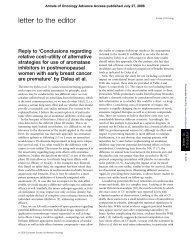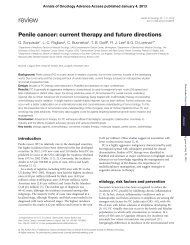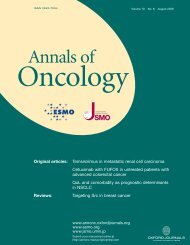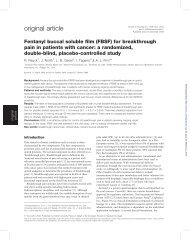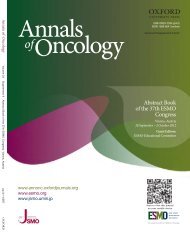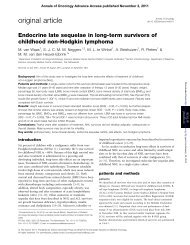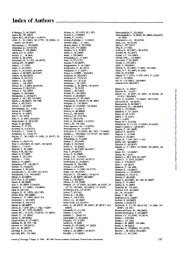5. CLL
5. CLL
5. CLL
Create successful ePaper yourself
Turn your PDF publications into a flip-book with our unique Google optimized e-Paper software.
<strong>5.</strong> <strong>CLL</strong><br />
234 235<br />
ICD23 AND iCD54 IN B-CELL CHRONIC LYMPHOCYTIC<br />
LEUKAEMIA. ANALYSIS OF CLINICAL SIGNIFICANCE.<br />
Stefano Molica 1 , Domenico Levato 1 , Matteo Ddl'Olio 2 , Roadla Matcra 2 , Mart*<br />
MioervinP, Angela Danilo 1 , M_Antonictta lorfida 1 , Mario Carotenuto 2 ,<br />
PellegrinoMiato*<br />
'Drvuionc di EmalologU, Azienda Oipcdaliera Tugliese-Ciaccio",<br />
8J100 - Catanzaro, ITALY.<br />
2 Drvmone di Fnnnni^gif IRCCS Ospedtlc 'Cats Sollicvo ddla Soflercnza*.<br />
S. Oiovinni Rotonoo, ITALY.<br />
In 95 B-ccll chrocic lymphocytic tqikcmm (<strong>CLL</strong>) patient] (44 lUge A, 31 stage<br />
B, 20 stage C.) fbOowed-up in two bcmatological institutions, serum levels of<br />
cither sCD23 or sCD54 were significantly increased in comparison to an agematched<br />
control population. After setting a cutt-off at the mean value for both<br />
these molecules (sCD23, 2834 U/ml; sCD54, 600 ng/ml) a correlation with other<br />
prognostic factor was attempted. Increased levels of sCD23 and iCDJ4 in B-cell<br />
<strong>CLL</strong> reflected dinico-biologicai parameters representative of either tumor mass<br />
(i.e., clinical stages, pattern of BM invorvrnent, absolute peripheral blood<br />
lymphocytosis) or disease-progression (i.e., lymphocyte doubling time, Ki67<br />
expression on BM lymphocytes, serum thimidine lunate activity). Life expectancy<br />
was significantly shorter in <strong>CLL</strong> patients with higher sCD23 levels (P < 0.001).<br />
The same applied for those with increased concentrations of sCD54 (P < 0 001).<br />
After adjusting for the most important prognostic factors in <strong>CLL</strong> (i.e., clinical<br />
stages, BM histologies) sCD23 lost its predictive power. In contrast, sCD54<br />
seemed to be partially independent from either clinical stages or BM histology<br />
Indeed, it could help to isolate two patient subgroups with different prognosis<br />
among stage B patients. After integrating sCD34 into Binet clinical staging<br />
patients could be separated into four groups whose observed/expected (O/E)<br />
ratios were as follows : (I) stage A, 0.37; (II) stage B with jCD54 < 600 ng/ml,<br />
0.51; (HI) stage B with sCD54 > 600 ng/mL 2.63; (IV) stage C, 3.37 (P 3 2-COA cydet<br />
Uroup 1<br />
2(1-1:<br />
21/17<br />
3<br />
oompWa • partial rwrfntai 24(S3%)<br />
nochanoa + progression 14<br />
nacoon (nnu gnoa)<br />
0<br />
22I SH<br />
3-4<br />
Uftlakuk*) (3-4.WHO gndi)<br />
nauroprii 10(20%)<br />
l>ui4jOcytn 4(11%)<br />
lyiHim->'aib0Jx10 a > r ) 22p8%)<br />
Qiji<br />
0J7<br />
0X04<br />
O70<br />
O001<br />
aw<br />
me<br />
aoooi<br />
Conclusion: The standard 2-CDA dosage of 0.7 mg/xg/cyde induced a high response<br />
rate In pretrealed tow grade NHL but was awodatnd with a considerable Incidence ol severe<br />
Infections (pneumonia, staphytococcus septicaemia, nocardknls, brain zoster). The dose<br />
reduction by 30% led lo an Impressive decrease of the Infection risk (2%. enterobacter<br />
septicaemia) whBe an equivalent response rate was maintained. Grade 3-4 myetotoxicity<br />
was acceptable In both groups and other severe adverse effects were rare. The results are<br />
not based on a randomised comparison. Even If we interpret them with the necessary<br />
caution, we conclude that a 2-COA dosage of 0.5 mg/Vg/cyde sc should not be exceeded In<br />
this patient population.<br />
<strong>5.</strong> <strong>CLL</strong> 67<br />
Downloaded from<br />
http://annonc.oxfordjournals.org/<br />
by guest on December 31, 2012
238 239<br />
RESPONSE AND TOXtCtTY OF ClAORBME (2-COA) AS FIRST (JNE<br />
TREATMENT OF LOW-GRADE NON-HOOQKIN'S LYMPHOUAS (NHL).<br />
PRELIMINARY DATA OF AN AUSTRIAN MULTTCENTER TRIAL<br />
MA Fridrfk, G. JflQef, H.J. Klenzar, H,. Hausmaninger O. Krieger. M. Nsubau«r,<br />
C. Gattringer, P. Oppttz, L Schiller, T. Radaskrewtez, W. Unkssch. ARQE Mod.<br />
Tumorther. 1« Dept of Medicine AKH-Unz, A-4020 Unz, Austria, Europe<br />
2-CdA Is an effective drug In heavily pretested low-grade NHL. In these patients<br />
serious Infectious problems were reported. Aim of our trial is to evaluate efficacy<br />
and tojdcity of 2-CdA In untreated pattern* with low-grade NHL<br />
Previously untreated low-grade NHL stags 3 or 4 were eflgtole to the trial. The<br />
protocol was approved by the beat ethics committee*. From June 93 to October<br />
95 51 patients gave Informed consent and were entered to the trial. 2-CdA was<br />
given as a 2-hour infusion 0.12 mgAg dafly for 5 consecutive days. Four treatment<br />
cycles were given every 28 day*. After the last cycle of 2-CdA, patients were<br />
treated with lnterteron-a-2c for one year.<br />
Twenty-eight ol the 40 patients have completed the 2-CdA therapy. Of these patients<br />
one was excluded because o) stage 2 disease, this patient achieved a<br />
partial remission. Median age was 5<strong>5.</strong>4, range 24-74 years. Response rate was<br />
80% (22/26, complete remlsston:19%, 5/26) Alter a median observation period of<br />
110 days (27 to 692 days) 6 relapses occurred after 56, 60,64,138, 259. and 344<br />
days respectively. Four patients died, afl of progressive tymphoma Toxictty WHO*<br />
3 possibly related to 2-CdA occurred in 6 patients (23%) and in 12 of 86 cycles<br />
(13%). Grade 3 toxtaUes were hemalologlcal, except one infection. One WHO* 4<br />
toxfcfty (potyneuropathy) was observed during 86 cycles (1%) ImmurogbouUn G<br />
levels dropped from median 11.90 gA. to 10 89g/L, CD 4 counts from median 0.7<br />
X10VL to 0.112 X10VL After a median time ol 22 months after treatment start the<br />
median CD count still was 0.146xi0*7L Despite this considerable toxictty to CO 4<br />
cells, only 6 Infections were observed during 73 treatment courses (8%)<br />
Conclusions: 2-CdA is an effective treatment In low-grade NHL. Infection rate Is<br />
low and treatment was well tolerated by previously untreated patients.<br />
240 241<br />
2-CHLORODEOXYADENOSINE (2-CDA) IN THE TREATMENT OF PREVIOUSLY<br />
UNTREATED LOW GRADE NON HODGKIN LYMPHOMAS - PRELIMINARY RESULTS<br />
OF A PHASE-ll-STUDY<br />
P. S. Mitrou (I), M. Rummel (IX L. Leimer (2), A. Knuth (3), H. ROckle (4), K. Schumacher<br />
(2), D. Hossfeld (5), L. Bergmann (I). D. Hoelzer(l)<br />
(1) J. W. Goethe-Univeriity Hospital, Medkal Clinic III, Hemitology, Theodor-Stern-Kal 7,<br />
60590 Frankfurt, Germany; (2) RBK Stuttgart; (3) Nordwest Hospital Frankfurt; (4) University<br />
Hospital WOrzburg; (5) UKE Hamburg<br />
2-CdA (2-Chlorodeoxyadenosinc) has been reported lo be an effective treatment in previously<br />
treated low grade lymphomas. Arm of the mullkcnier-study if to evaluate the rale and duration<br />
of remissions and to examine toxlchy and immunosuppressive effects of 2-CdA in low grade<br />
lymphomas as firn line therapy or in first relapse Treatment schedule: 2-CdA 5 mg/m 1 as two<br />
hour infusion day 1-5, for a maximum of six cycles every four weeks. Inclusion criterialymphocytic<br />
and immunocytk (ic) stage III and IV, centrocytic (cc) (mantle zone) slage III and<br />
IV, centroblastk-centrocylic (cb-cc) stage IV, other low grade lymphomas. 41 pu entered the<br />
study. 28 po. are eviluable for response, 9 pu Hill under treatment and 4 pu. not evaluable.<br />
16 out of 28 pu. responded to CdA (table).<br />
CR<br />
PR<br />
NC<br />
Progression<br />
Early death<br />
cb-cc (n-12) cc (n-6) ic (n=5) other entity (n-5)<br />
4*<br />
4<br />
3*<br />
1<br />
-<br />
-<br />
1<br />
1<br />
4*<br />
-<br />
1<br />
4<br />
-<br />
-<br />
-<br />
1 (T-zone)<br />
1 (MALT)<br />
1 (cut T-cell)<br />
1 (Sezary)<br />
1* (T-cell)<br />
F^chutcrbl.C)<br />
stand* fur one<br />
patient treated<br />
in fina rcUpsc<br />
From the results so far 2-CdA seems to hive a delayed antiprolifentive activity which in some<br />
cases can be observed still weeks or months after cessation of chemotherapy. Continuing<br />
improvement of tumor parameters such as regression of bone marrow infiltration, size of<br />
lymph nodes and decrease of monoclonal gammopathtes was delected. Toxicity: Neutropenia<br />
grade 3 occured in IS of 146 evaluable cycles, grade 4 was not observed. Thrombocytopenia<br />
grade 3 occurred in 2 of all evaluable cycles, grade 4 did not occur. CD4-lymphocyles<br />
decreased in every case with a median of 570/ul before treatment, 345/ul after 3 and 225/ul<br />
after 6 cycles. Infections: I reactivated tuberculosis, I bacterial pneumonii and I herpes zoster<br />
Other side effects were not observed. Summary: Because of iu mild unkity the presented<br />
regimen can be administered in an outpatient facility. It is effective in untreated pu. or in first<br />
relapse. From the preliminary results it appears thai cc lymphomas (mantle zone) respond<br />
poorly to CdA compared to other entities. The long-term immunosuppressive effect and hs<br />
consequences are not evaluable so far nor is remission duration.<br />
THREE-DAY THREE-WEEKLY ORAL CLADRIBINE (2-CdA) FOR<br />
CHRONIC LYMPHOCYTIC LEUKEMIA. A PRELIMINARY<br />
REPORT FROM A EUROPEAN PHASE II MULTICENTER<br />
STUDY. Karin Karlsson, Mats StrOmberg, Steven Johnson, Andre 1<br />
Delannoy, Jan Liliemark, Gunnar Juliusson, and Swedish collaborators.<br />
LinkOping, Taunton, Brussels, Stockholm; Sweden, England, Belgium.<br />
In our previous studies of 117 patients with symptomatic chronic<br />
lymphocytic leukemia, five-day monthly cladribine courses resulted in an<br />
overall response rate of two thirds, and half the responses were complete.<br />
The median CR duration was 42 months, and the PR duration 18 months.<br />
However, one third of the patients had major infections, and 13% developed<br />
thrombocytopenia. We therefore embarked on a schedule with lower total<br />
dose per course but the same dose intensity aiming at a reduced loxicity.<br />
From January 1995 through January 1996, 89 symptomatic patients from<br />
Brussels (B), Taunton (UK), and 18 Swedish institutions were entered. Oral<br />
cladribine 10 mg/sqm/day was given days 1 through 3 every 3 weeks, for up<br />
to 10 courses. Stopping criteria were defined at various stages for patients<br />
with certain signs of toxicity, and/or insufficient improvement from therapy.<br />
Thirty-four patients with a median age of 64 (range 41-88) are<br />
currently evaluable for a preliminary analysis. Binet stages were as follows<br />
A:5, B:13, C:16. Twenty-five (74%) were previously untreated. The overall<br />
response rate were 65%, with 7 CR (21%) and 15 PR (44%) after 5 to 10<br />
courses. Seven patients had pneumonia, and one patient developed severe<br />
hemolysis.<br />
The final analysis of the study will tell if this treatment schedule in<br />
combination with defined criteria for stopping therapy will reduce toxicity<br />
with retained response rate as compared to the previously studied regimes.<br />
Studies in multi-institutional settings are required before proceeding into a<br />
phase-Ill comparison of cladribine, fludarabine and chlorambucil for<br />
symptomatic <strong>CLL</strong>.<br />
2-CHLORODEOXYADENOSINE (2-COA) THERAPY IN HAIRY CELL LEUKEMIA (IICL):<br />
COMPARISON OF 7 DAY CONTINUOUS IV INFUSION WITH A TWO-HOURS IV INFUSION<br />
ON 5 CONSECUTIVE DAYS.<br />
G Vettioef, P. Zachee, P. Vandenberghe, H. Demuynck, J. Maertens, S. Phtaluga C. De Wolf-<br />
Peetets and M. Boogaerts. Department of Hemalology and Pathology, University Hospital,<br />
Leuven, Belgium.<br />
2-CDA is > purlne analogue with excellent activity in HCL. A 7-day continuous i.v. infusion<br />
may be considered standard administration. Since a more convenient route of administration is<br />
desirable, we compared the activity of standard administration ofa single 7-day continuous i.v.<br />
infusion (O.I mg/kg/day) (n-21; newly diagnosed, 6; pretreoted with spleneclomy and/or<br />
interferon-alpha, 15) with an out-patient regimen ofasmgk cycle of 2-CDA (0.1 mg/kg/day) as<br />
a 2-hours i.v. infusion on 5 consecutive days (n-13; newly diagnosed, 8, pretreated, S). All<br />
patients had at least Hb



